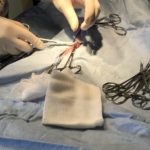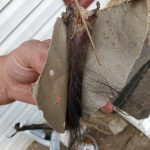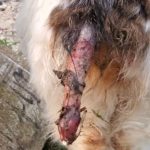Since she’s only 9 weeks old, you can’t have had her long. Which means either you have a vet visit happening in the next couple of days, right? Ask your vet. 🙂
My 10 yr old Maltese was laying on my bed. When I took her off of it the area she was laying on was very wet. Not urine wet. There was no odor. But I could feel the wetness and see where it stained. Although it was very light. Her body wasn’t wet. I know that it wasn’t from anything else. She was showing signs of being nervous when I first put her there. It’s very confusing.
Comments
I’ve got a 9 week old puppy at home, she is passing stools normal colour not to much but is crying when trying to pass. She has been wormed and I’ve just given her, another one as requested by previous owner. Will this fade eventually once worms are killed she is scooting her bum on the floor too
Comments
Two days ago my 8 month old puppy had diarrhea & little pieces of his buffalo chew horn in it. I took away the horn & threw it away bc I didn’t like the fact that he was swallowing pieces. I assumed the diarrhea was from irritation of not being able to digest it. He had no diarrhea yesterday & was totally fine. This morning I woke up to diarrhea on our floor & later he threw up a small amount. His throw up had another little piece of the buffalo horn in it. He is still acting like his very hyper self & is drinking & eating like normal. My question is do you think his stomach is still just a little irritated & trying to get back to normal? Or is this something I should be really concerned about & get him seen?
Comments
I rescue kittens and find them forever homes. I currently have 5 kittens. Took them for initial check up Friday. All have upper respiratory infections. I was given Clavamox and terramycin eye ointment. One has developed severe conjunctivitis despite above treatment. Went back to vets and was told to continue above meds. The last kitten I had with this required an antibiotic injection. This kittens eyes have gotten worse since Friday not better. I am frustrated and this kitten is miserable.
Comments
Our outdoor cat (1yr) wasn’t around during the day, like she usually is, for lots of love. When she finally came around that night, we noticed the top of her tail seemed skinned on the bottom part (just meaty flesh), about 2.5inches. We went to our local farm store and bought a spray to keep infection out and help heal. She seemed to feel better a couple days later, eating and coming around more. Then we noticed the whole tail was looking abnormal, like skinned, with fur hanging. She became more herself, following us around property, wanting alot of love, moving easily, jumping up on things, eating well. 2.5 weeks since this first began, and today, the whole outer part came off! It was almost like a cacoon type looking, hollow inside! All the hair and everything is now gone, just about 4-5″ of completely bare flesh.
I have documented with video/pictures the whole time. We weren’t sure if an animal tried to bite her, or she had gotten it caught in a trap? We love her so much, my 5yr old has raised her after her mommy died 6wks after birth. We are a one income family, and my husband is about to have surgery that we have to pay for upfront, as well as coming up with the money the short term disability won’t pay for 6wks…we are at a loss?
First pic is how it has looked for about 2 weeks, then the other 3 pics are from today ?)















I would watch carefully to see if you continue to notice “wet spots” where she lays. My dog has Spay-Induced Incontinence, she leaks urine when she is sleeping. It is often odorless as well as my girl also has a condition where she does not concentrate her urine. If you continue to notice these wet spots a trip to the vet would be warranted to see if there is a medical cause and treatment. Best of luck!
I agree with Jenn. It sounds like urine to me. Sometimes when urine is dilute it has very little odor. At 10years old, I would definitely recommend some baseline bloodwork and a urinalysis.